|
Wednesday, Sept. 11
- Breakfast: breakfast pizza
- Breakfast: ham, egg and cheese English muffin
- Ranch house steak sandwich
- Smart cuisine: sweet and sour apricot chicken
- Italian lasagna
- California club
- Tex-Mex grilled-chicken salad
- Texas-style chili
- Tomato florentine soup
Wilson Hall Cafe menu |
|
Wednesday, Sept. 11
Lunch
- Vietnamese caramelized pork and rice noodle salad
- Pomegranate poached pear
Friday, Sept. 13
Dinner
- Gazpacho
- Chili-glazed halibut with avocado tomatillo sauce
- Lemongrass rice
- Sauteed pea pods
- Pineapple flan
Chez Leon menu
Call x3524 to make your reservation.
|
|
'Why particle physics matters' winner announced
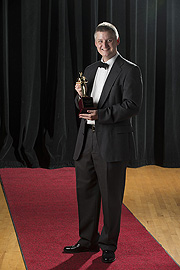 |
| The readers have spoken: Your favorite explanation of why particle physics matters came from physicist Breese Quinn. Photo: Reidar Hahn |
At a major particle physics planning meeting this summer, a couple of dozen physicists volunteered to speak on camera about why they do what they do. We at symmetry chose our top five explanations and asked you to vote for your favorite.
The results are in: University of Mississippi physicist Breese Quinn is the winner of the very first symmetry "Excellence in Science Communication" award, affectionately nicknamed the "Symmy." [Monday] he gamely agreed to pose for an awards-show-themed photo with his prize.
Read more
—Kathryn Jepsen
|
Nominations now accepted for director's volunteer award
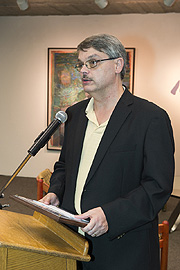 |
Last year, Fermilab recognized Don Lincoln for his contributions to the laboratory's K-12 education programs. Photo: Reidar Hahn
|
The Education Office is now accepting nominations for this year's Director's Award for exceptional volunteer service, sponsored by Fermilab Friends for Science Education.
Each year, more than 200 employees, users and contractors go above and beyond their everyday duties to further outreach and education at the laboratory.
These volunteers are role models and mentors for teachers and students, answer tough questions about Fermilab and its science, maintain Lederman Science Center exhibits, visit area classrooms and more.
Once a year at a reception, the laboratory recognizes the efforts of an especially dedicated volunteer with the Director's Award.
If you've been impressed by a colleague's education or outreach contribution, let the Education Office know. You may nominate a Fermilab staff member, user or contractor. The Education Office will take nominations until Sept. 25. This year's reception will take place on Oct. 3.
|
Accelerator update, Sept. 10
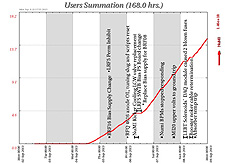 |
Fermilab began sending the first neutrinos to the NOvA detector in Minnesota on Wednesday, Sept. 4. By the end of Sunday, the accelerators had delivered an integrated luminosity of 1.46 x 1018 protons on target. The red line indicates a steady increase in delivered protons.
|
Linac and Booster
AD personnel operated the Linac and Booster accelerators, tuned the machines and conducted machine studies. A newly refurbished RF cavity will be installed in the Booster this week, and another one will be removed for refurbishment at the same time.
Main Injector/NuMI
The Fermilab accelerator complex sent the first post-shutdown neutrino beam to Minnesota on Sept. 4. Within a few days, the Main Injector already achieved the beam power of 80 kilowatts, almost a quarter of the pre-shutdown beam power. By Sept. 9, the Main Injector had delivered an integrated intensity of 1.46 x 1018 protons to the carbon target in the NuMI beamline during approximately 96 hours of beam delivery. MI vacuum pump trips limited intensity and beam operation helped scrub the vacuum, improving it, so that beam power was up to roughly 170 kilowatts by Monday. Accelerator experts worked on lattice measurements, studies and machine tuning to increase the beam intensity in the Main Injector.
Fixed-target area
Operators and experts had trouble sending beam from the Main Injector to the Switchyard absorber. Machine experts are examining the beam extraction in the Main Injector and the settings for the beamline from the Main Injector to the Switchyard. The Test Beam Facility is ready to receive beam when it becomes available. The installation of the pipe for the Neutrino Muon beamline, which delivers beam to the SeaQuest experiment, is complete. Checks by alignment, installation of removed components, vacuum flanges and other work remains.
View the AD Operations Department schedule.
|
|
Save a tree: practice mindful printing at Fermilab
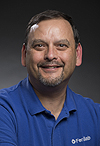 |
|
Mark Kaletka
|
Mark Kaletka, deputy head of the Core Computing Division, wrote this column.
The laboratory uses an estimated 15 to 20 thousand reams of paper each year for printing, copying and faxing. Factor in the cost for ink or toner, as well as maintenance and repair of equipment, and you find that the price of putting an image on a piece of paper adds up pretty quickly. This is not even to mention the environmental costs of harvesting and processing trees into paper and recycling our waste paper. (You are careful to put waste paper in the recycling bin and not the trash bin, right?) For both budgetary and environmental reasons, it makes a lot of sense for us to think about our printing and copying habits and to reduce our use where we can.
The first thing to think about is whether you need to make a printed copy at all and, if so, why. The overwhelming majority of documents begin as an electronic document of some kind and really don't need to be put on paper. For instance, I recently needed some information from someone at the lab. He printed the information on paper and then scanned the paper to make a PDF to email to me. He could have just saved it directly as a PDF and skipped the physical copy, saving his valuable time as well as a piece of paper that went straight into the recycling bin! Perhaps out of habit, many meetings still include paper agendas and copies of documents even though the same information has already been distributed electronically to attendees in advance. With the many ways we now have of sharing electronic documents, the need to share paper documents should diminish.
When we do need to print, we should make smart choices to reduce costs. A color page costs about six times as much to print as a black and white page. Duplex, or two-sided, mode reduces paper usage. Printing in "draft" mode reduces toner and ink costs. Over the next few months, the Core Computing Division will roll out new services that, along with other changes, will provide much better data to organizations about their printing habits and how to help reduce costs.
|
RX-J2248 galaxy cluster
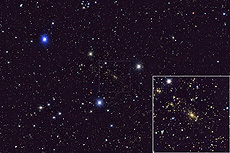 |
| Beginning with today's Photo of the Day, Fermilab Today will regularly feature snapshots taken with the Dark Energy Camera. This image shows the galaxy cluster RX-J2248, named for the ROSAT X-ray telescope, with which it was discovered. It has hundreds of old red galaxies as well as a massive amount of dark matter. View more of these snapshots and learn more about what you see at the Dark Energy Detectives website. Photo: Dark Energy Survey collaboration |
|
ESH&Q weekly report, Sept. 10
This week's safety report, compiled by the Fermilab ESH&Q section, contains two incidents.
An employee was struck by an insect. Several minutes later he noticed a white spot with some swelling. He received first-aid treatment.
An employee experienced itching, and red spots appeared on her legs and abdomen. The employee had trimmed weeds at Tank Farm. She was examined at the Medical Office.
Find the full report here.
|
How particle physics can make a better world
From the Mother Nature Network, Aug. 29, 2013
Is there any more esoteric, almost mystical-sounding scientific field than particle physics? To the layperson, the discipline is shrouded in impenetrable particle names like anti-down quarks and neutralinos, and the counterintuitive rules of quantum mechanics. In an effort to make their field more concrete and meaningful to the rest of the world, a group of particle physicists has produced a series of videos on "Why Particle Physics Matters."
Read more
|
|